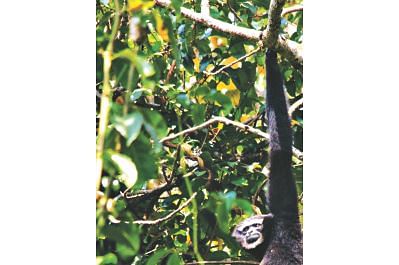Finding <i>Ulluk </i>

Hoolock Gibbon at Lawachara. Photo: Ihtisham Kabir
A major attraction of Lawachara National Park is the Hoolock Gibbon (known as Ulluk in Bangla.) This ape, which lives in Bangladesh, India, Southern China and Myanmar, is endangered worldwide and critically so in Bangladesh. There are several families of them living in Lawachara.
Apes are different from monkeys. They have bigger brains and no tail. Hoolocks enter into lifelong monogamous relationships, produce 5-6 babies during their life and can live for 30 years.
Having read about it, I wanted to see a Hoolock Gibbon with my own eyes.
I did not know my way around Lawachara and was short on time, so I decided to short-circuit potential frustrations by opting for a guide to help me find an Ulluk.
Guides are trained by the Nishorgo Network (www.nishorgo.org, funded by USAID) and know the trails, fauna and flora of protected forests of Bangladesh.
I met my guide Razbe one morning and we entered Lawachara, which is eight kilometres north of Srimongol (about 4 hours from Dhaka by car.) There are three trails in the park: 0.5, 1 and 2 hours long. After passing the visitor centre under construction, we started hiking the long trail.
I had learned earlier from Pasha, my helpful contact at Nishorgo, that the Hoolocks start singing loudly between 9 and 10 am. As we walked through the dense forest, I waited to hear their voices.
The forest with its towering trees, dense undergrowth and fat creepers snaking around giant tree trunks was a thrilling if poignant reminder of this area fifty or hundred years ago. In 1956, scenes of the movie Around the World in Eighty Days showing Indian forests were filmed in Lawachera.
As we went deeper into the forest, Razbe continued looking up, scanning the tall trees. We saw several large black squirrels and heard numerous birdsongs. The birds, however, were at a great height, far from camera range. There was no sign of Ulluk.
Then about 9:30am, the singing – used to announce the family's territory – started loudly. There was no mistaking the loud “wau-wau†sounds used by groups of Hoolocks to communicate.
As we got closer to the source of the sound, Razbe led me up a dried stream to a point from which we could see several tall trees on a hillock, less than a hundred feet away. Soon we spotted the first Hoolock, a male (black.) As we waited, the female (brown) appeared as did a juvenile.
The dense jungle and overhead branches kept on getting in my way of capturing a clear photograph. Then the male saw us and turned his back towards us. The singing stopped.
Razbe informed me that while they are not afraid of humans, Hoolocks become cautious when they see us and often hide their face.
We watched and waited. The Hoolocks were soon effortlessly swinging from branch to branch, tree to tree, and I got my photograph. Presently they moved out of sight.
But those magical minutes of my first Ulluk sighting will be etched in my memory.

 For all latest news, follow The Daily Star's Google News channel.
For all latest news, follow The Daily Star's Google News channel. 



Comments